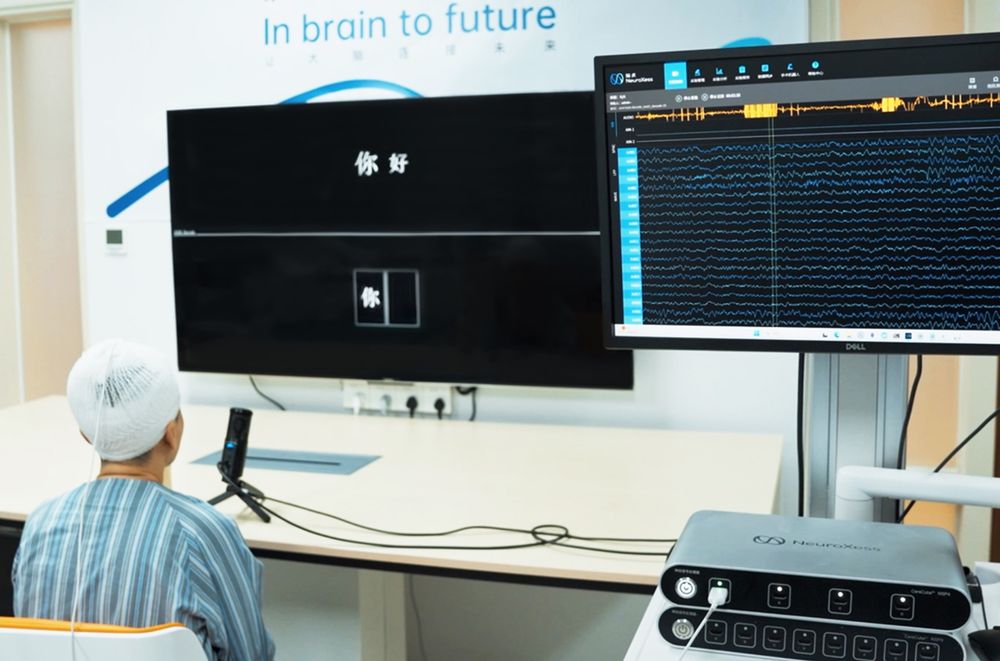
Cognitive error signals in the anterior insula propagate toward prefrontal cortex when a BCI fails to follow the user’s intention. Real-time integration enables a self-correcting neural interface that compensates for its own decoder misclassifications
#neuroskyence

Cognitive error signals in the anterior insula propagate toward prefrontal cortex when a BCI fails to follow the user’s intention. Real-time integration enables a self-correcting neural interface that compensates for its own decoder misclassifications
#neuroskyence
Scientists have recorded single neurons in the human LGN for the first time, revealing how it links the retina to visual cortex. When one eye is closed, neurons tuned to that eye reduce their activity, while neurons tuned to the open eye increase in spikerate
#neuroskyence

Scientists have recorded single neurons in the human LGN for the first time, revealing how it links the retina to visual cortex. When one eye is closed, neurons tuned to that eye reduce their activity, while neurons tuned to the open eye increase in spikerate
#neuroskyence
@changlabucsf.bsky.social #neuroskyence

@changlabucsf.bsky.social #neuroskyence
Paradromics has just received FDA IDE approval to implant their micro-electrode array in human participants. The neuralink competitor will soon start recruiting patients with speech/motor impairments at UC Davis, Mass General Hospital and U Michigan
#neuroskyence

Paradromics has just received FDA IDE approval to implant their micro-electrode array in human participants. The neuralink competitor will soon start recruiting patients with speech/motor impairments at UC Davis, Mass General Hospital and U Michigan
#neuroskyence
#neuroskyence @changlabucsf.bsky.social

#neuroskyence @changlabucsf.bsky.social
Spiking activity near intracortical stimulation sites proved to accurately predict the brightness and sharpness of perception. Using these signals in real time could one day optimize the individualized experience of each phosphene
#neuroskyence

Spiking activity near intracortical stimulation sites proved to accurately predict the brightness and sharpness of perception. Using these signals in real time could one day optimize the individualized experience of each phosphene
#neuroskyence
The company behind the stentrode just raised $200M in Series D funding, led by Double point ventures, Bezos Expeditions and ARCH ventures. The funding will be used to develop smaller stentrodes reaching multiple brain regions 🧠
#neuroskyence

The company behind the stentrode just raised $200M in Series D funding, led by Double point ventures, Bezos Expeditions and ARCH ventures. The funding will be used to develop smaller stentrodes reaching multiple brain regions 🧠
#neuroskyence

Researchers at UCSF used iEEG to map brain circuits in severe OCD, identifying the ventral capsule as bridge between the prefrontal cortex and limbic system. Multi-area DBS implantation led to rapid symptom improvement 🧠
#neuroskyence @changlabucsf.bsky.social

Researchers at UCSF used iEEG to map brain circuits in severe OCD, identifying the ventral capsule as bridge between the prefrontal cortex and limbic system. Multi-area DBS implantation led to rapid symptom improvement 🧠
#neuroskyence @changlabucsf.bsky.social
Researchers demonstrated that stimulation of the thalamus helped reduce seizures by over 80%. Their approach showed a reduction in epileptiform discharges, in line with the nuclei's critical role in seizure termination
#neuroskyence #neuroAI #neuroscience

Researchers demonstrated that stimulation of the thalamus helped reduce seizures by over 80%. Their approach showed a reduction in epileptiform discharges, in line with the nuclei's critical role in seizure termination
#neuroskyence #neuroAI #neuroscience
@science.xyz implanted 38 patients with macular degeneration with the PRIMA subretinal implant. Paired with camera-equipped glasses, the system improved central vision in 80% of participants, allowing them to read again
@maxhodak.bsky.social #neuroskyence

@science.xyz implanted 38 patients with macular degeneration with the PRIMA subretinal implant. Paired with camera-equipped glasses, the system improved central vision in 80% of participants, allowing them to read again
@maxhodak.bsky.social #neuroskyence
www.cell.com/neuron/abstr...
#neuroscience @picowerinstitute.bsky.social

These "proxies" let surgeons rehearse each procedure in advance.
🎥 youtube.com/watch?v=WhG-...

These "proxies" let surgeons rehearse each procedure in advance.
🎥 youtube.com/watch?v=WhG-...
www.tum.de/en/news-and-...

www.tum.de/en/news-and-...
Scientists used functional ultrasound imaging to record from primate parietal cortex over months. Their method combines high spatial resolution and long-term stability, revealing direction-tuned saccadic neural patches
#neuroskyence #compneurosky

Scientists used functional ultrasound imaging to record from primate parietal cortex over months. Their method combines high spatial resolution and long-term stability, revealing direction-tuned saccadic neural patches
#neuroskyence #compneurosky

More than 30 labs are joining forces in the tACS Challenge, a global effort to test one of brain stimulation's biggest questions.
🧵1/5
More than 30 labs are joining forces in the tACS Challenge, a global effort to test one of brain stimulation's biggest questions.
🧵1/5
The startup shows a 1,024-channel grid implanted through a cortical slit in pigs, and intraoperative neural recordings and stimulation in five humans at sub-mm resolution.
#neuroskyence @precisionneuro.bsky.social

The startup shows a 1,024-channel grid implanted through a cortical slit in pigs, and intraoperative neural recordings and stimulation in five humans at sub-mm resolution.
#neuroskyence @precisionneuro.bsky.social
A recent study used transfer learning on distributed iEEG recordings to enhance speech decoding. By learning shared latent manifolds, their cross-subject model outperformed individual models in a speech motor task.
#neuroskyence

A recent study used transfer learning on distributed iEEG recordings to enhance speech decoding. By learning shared latent manifolds, their cross-subject model outperformed individual models in a speech motor task.
#neuroskyence
#neuroskyence
By @steinmetzneuro.bsky.social, who led a big collaboration
www.sciencedirect.com/science/arti...

#neuroskyence
#neuroskyence #bci
TL;DR Deep learning lets us synthesize efficient stimulation patterns that reliably evoke percepts, outperforming conventional calibration.
www.biorxiv.org/content/10.1...

#neuroskyence #bci
ICMS affects both vascular and immune responses. Higher currents increase blood-brain barrier leakage, letting substances enter surrounding tissue. Soon after, microglia activate and cluster around highly active regions
#neuroskyence

ICMS affects both vascular and immune responses. Higher currents increase blood-brain barrier leakage, letting substances enter surrounding tissue. Soon after, microglia activate and cluster around highly active regions
#neuroskyence
#neuroskyence #bci #compneurosky
We built a platform that unites AI-based brain signal decoding with connectomics across 123 hours of recordings from 73 patients. A step toward adaptive, network-level neurotechnology.
www.nature.com/articles/s41...

#neuroskyence #bci #compneurosky
Scientists mapped the precise nerve circuits causing dangerous spikes in mice, rats, and humans. By stimulating these circuits with epidural electrical stimulation, they activated a competing pathway that stabilized blood pressure.
#neuroskyence

Scientists mapped the precise nerve circuits causing dangerous spikes in mice, rats, and humans. By stimulating these circuits with epidural electrical stimulation, they activated a competing pathway that stabilized blood pressure.
#neuroskyence
Swiss and Canadian researchers developed an implantable system that epidurally stimulates three thoracic segments, triggering a strong pressor response and rapidly reducing hypotensive symptoms.
#neuroskyence #sci #onward

Swiss and Canadian researchers developed an implantable system that epidurally stimulates three thoracic segments, triggering a strong pressor response and rapidly reducing hypotensive symptoms.
#neuroskyence #sci #onward

